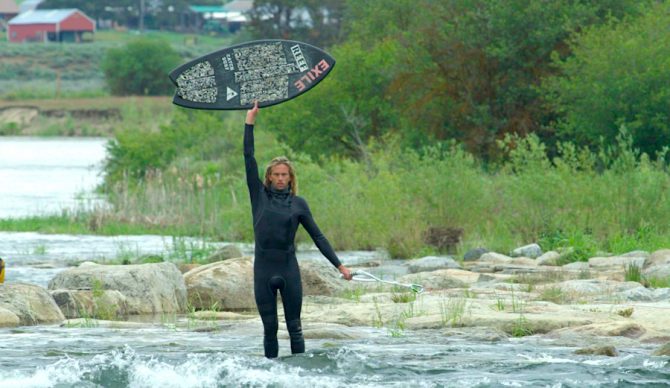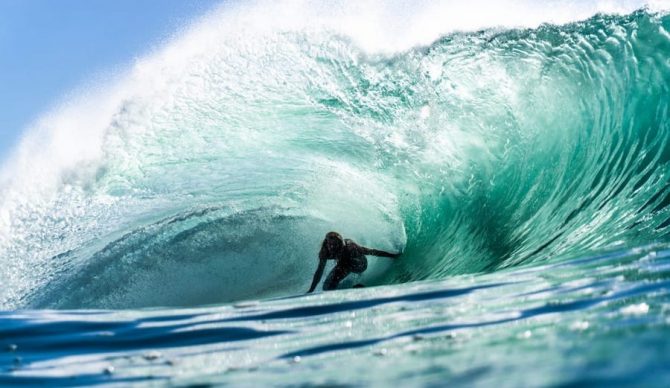
Blair Conklin, on a river in Idaho. Viral content has helped these skimboarders solidify their income. Photo: The Inertia
Three-time world champion skimboarder Lucas Fink is used to his videos going absurdly viral. One video of him sliding out to ride shorebreak on his skimboard and wrapping it back to the beach has garnered 26 million views on Tiktok. The maneuver in the video is pretty pedestrian by his elite standards, but apparently the masses scrolling on social media are eating it up. The Brazilian regularly posts videos that get over a million views.
Another former three-time world champion skimboarder from Laguna Beach, Blair Conklin, has used skimboarding to become a viral star on social media as well. He’s racked up 2.2 million YouTube subscribers, 1.7 million Tiktok followers, and 300k Instagram followers.
If you follow ocean sports, you’ve probably heard of these two skimboarders, or came across their videos while scrolling through your feed. But it’s likely that it wasn’t skimboarding in its traditional sense that brought them to your attention.
For Fink, getting towed into monster waves at Nazare on his finless skimboard thrust him into the limelight. And for Conklin, it could be argued that it was his skill wave pool surfing with alternative boards – soft tops and skimboards – that brought him fame.
Both athletes have had to look beyond their original sport of skimboarding to make a living. But why isn’t being the world’s best professional skimboarder enough to pay the bills? Fink and Conklin both have an online presence that keeps pace, or even outperforms, other well-paid professional freesurfers.
I caught up with both to understand the struggles of trying to make a living fins-free.
“Whenever I’m in a conversation with a new sponsor, or renewing a contract, they always tell me that skimboarding is small, so they can’t invest a lot in it,” said the 25-year-old Fink. “But I say, sure, skimboarding is small, but apparently people like skimboarding content because it can go as viral, or even more so, than surfing.”
View this post on Instagram
“After my first world title in 2019 I had a good amount of sponsors and I started living off skimboarding,” added Fink, who estimates the sport brings him revenue between USD $50k and $100k per year. “But still, I reinvest pretty much everything I make into my career. I am lucky because I have the basics covered. I still live with my parents. But if I didn’t have that support, I wouldn’t be able to travel around and invest in new projects and my career to get better results.”
For Fink, his fame transcended skimboarding when he decided to take on the powerful waves of Nazare. Red Bull even made a short film about him.
“(Big wave skimming) gave me a different title,” explained Fink. “Not only was I world champion, but also the guy that rode the biggest wave ever on a skim.”
But the fame didn’t automatically translate into financial returns.
“That opened up new opportunities for me to be doing projects representing different brands,” added Fink. “But I wouldn’t say it was immediately a big change. Big wave skimboarding required me to spend a lot more money than just doing skim contests. There are costs: a Jet Ski, the fuel, the driver, and buying clips.”

These guys are talented in any type of waves. Blair Conklin, deep in the belly of the beast. Photo: James Ferrell.
Like Fink, Conklin’s big break was when he stepped away from shorebreak skimming at home. In Conklin’s case, he decided to try his skills in a wave pool. (The man can also tear apart a river wave.)
“I used to compete on the United Skim Tour, which was great for the ten years that I did it, but it was never going to be enough to afford to live in California, especially my hometown of Laguna Beach,” said the 28-year-old Conklin who also holds a degree from UC Berkeley.
“I was voted into the Waco Stab High contest (in 2018) and I ended up doing pretty well in it riding a soft board,” Conklin recalled. “CatchSurf was already supporting me at this time, but after the Stab High event I was approached by Reef sandals. I’ve been riding for them ever since. Basically, I didn’t start making a living off of skimboarding until I was sponsored by some surf companies. That really boosted me and allowed me to pursue what I love to do full time. I guess I have wave pools to thank a lot for what I’m doing these days.”
It’s clear that surf brands are not as likely to throw money at skimboarders compared to surfers. But what is it particularly about skimboarding that holds it back? Conklin has a theory.
“It’s kind of a sad state of affairs,” said Conkin. “There are a lot of really talented skimboarders that are placing first on the tour and once they win they don’t have a whole lot of support.”
“(Skimboarding is) a fraction the size of surfing,” added Conklin. “It’s so difficult to learn and get good at that there aren’t as many people that do it. Therefore there isn’t an industry that’s thriving around it.”
Now that they’ve made it big (at least in skimboard terms), both Fink and Conklin have found their niches to milk skimboarding for dollars. Fink gets support from RedBull and various brands that pay for one-off sponsored social media posts. He’s also looking to diversify his income and get into the business of paid speaking engagements. Aside from CatchSurf and Reef, Conklin counts on support from DJI and I-SEA sunglasses to complement the revenue generated by his YouTube channel. Both riders also have support from Exile Skimboards.
Today’s professional skimboarders find themselves in no-man’s land. They have mastered a difficult, visually appealing sport that draws attention on social media, but few brands are willing to put game-altering money into it. Will this ever change? Is there a brighter future for skimming? Conklin and Fink seem to think so.
“I think (skimboarders) just need to figure out the right formula to make it work out,” said Fink. “Maybe the tour format is obsolete. They need to change it or change how they’re creating content on top of it. I’m not sure. But I’m confident that skimboarding has been growing. I think it’s just a matter of time.”
“I think that a lot of the top pros right now could make a living off of skimboarding if they focused on creating videos and media,” said Conklin. “I think there’s so much talent out there and they would be surprised with the attention that they get.”
“I don’t think the United Skim Tour is ever going to be the WSL,” added Conklin. “But I could be wrong. People love watching skimboarding, whether they enjoy ocean sports or not. They find it fascinating that you can run your ass off, drop a board, slide 100 yards out to a head-high wave, and make it back to the beach without even touching the water. So there’s definitely a jaw dropping element to skimboarding. And I think that if the tour can figure out how to produce media like the WSL does, then we might have some better sponsorships of these events (that leads to more prize money).”
So, what is the future of skimboarding? Perhaps, Fink and Conklin are the pioneers breaking new ground for those who follow in the future. Or perhaps, they are just exceptionally creative, talented athletes who found a way to make it work financially. There may be a distant future of lucrative careers for professional skimboarders, but for now, the sport’s best will continue searching elsewhere for paychecks.
Watch Blair Conklin surf some of the best river waves in the U.S. in Skim River.

